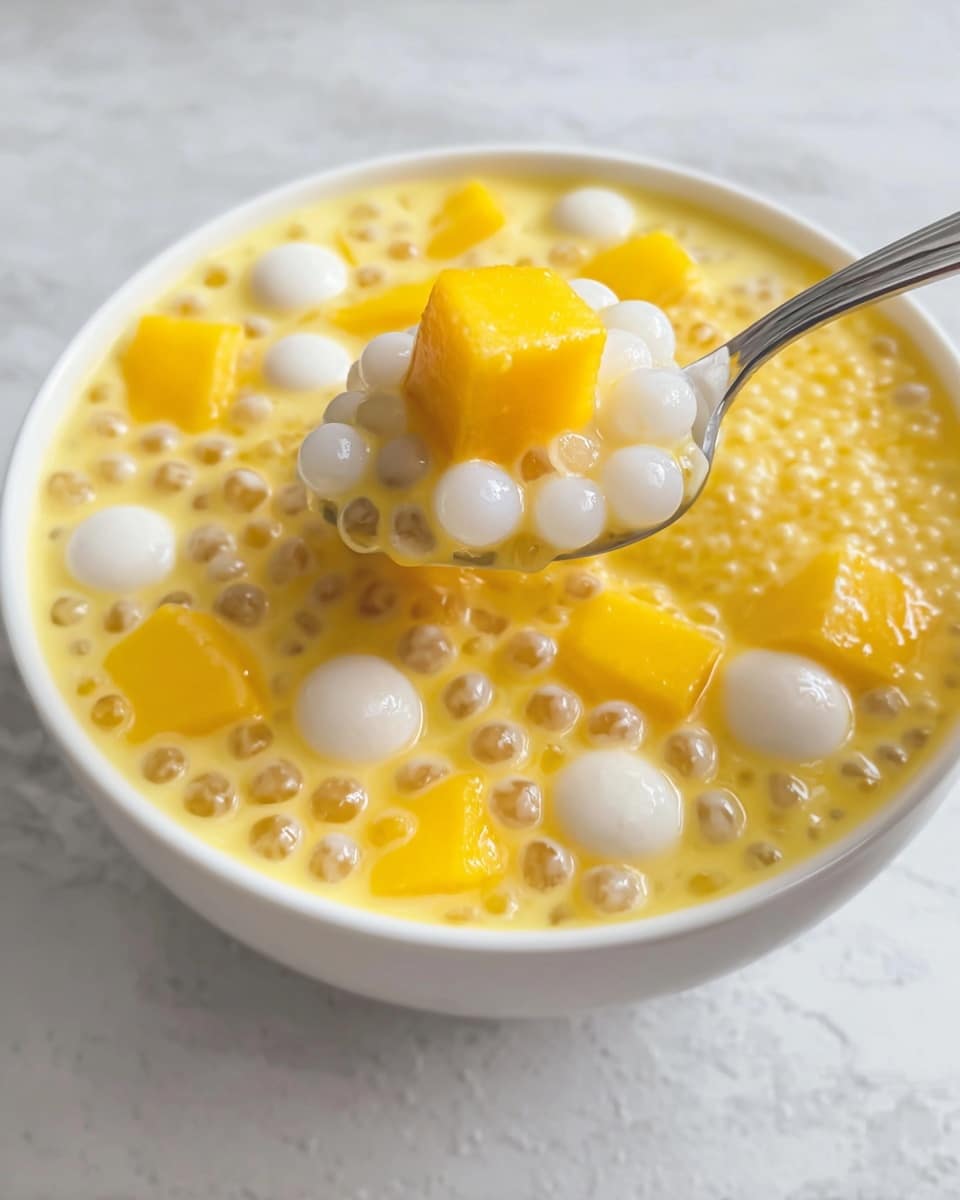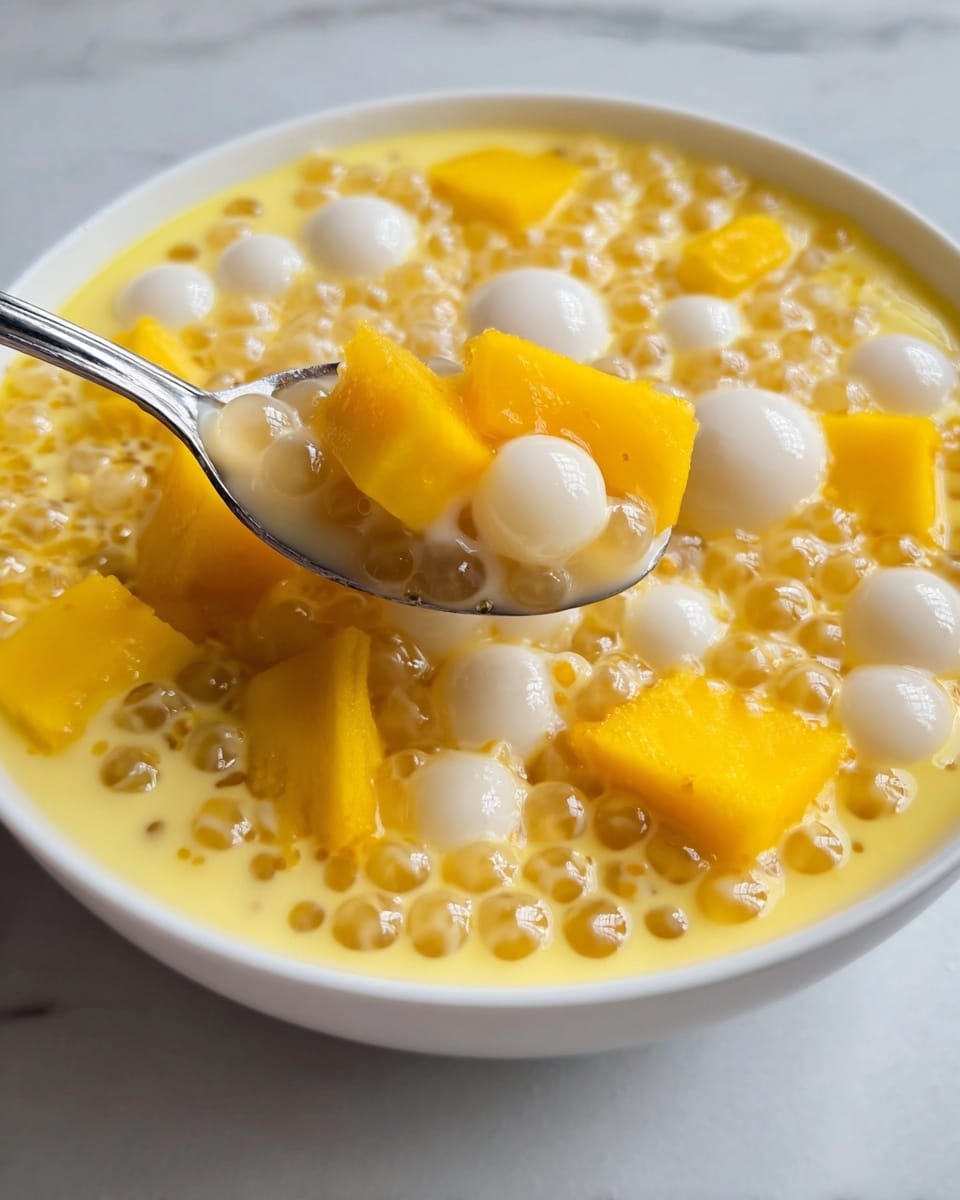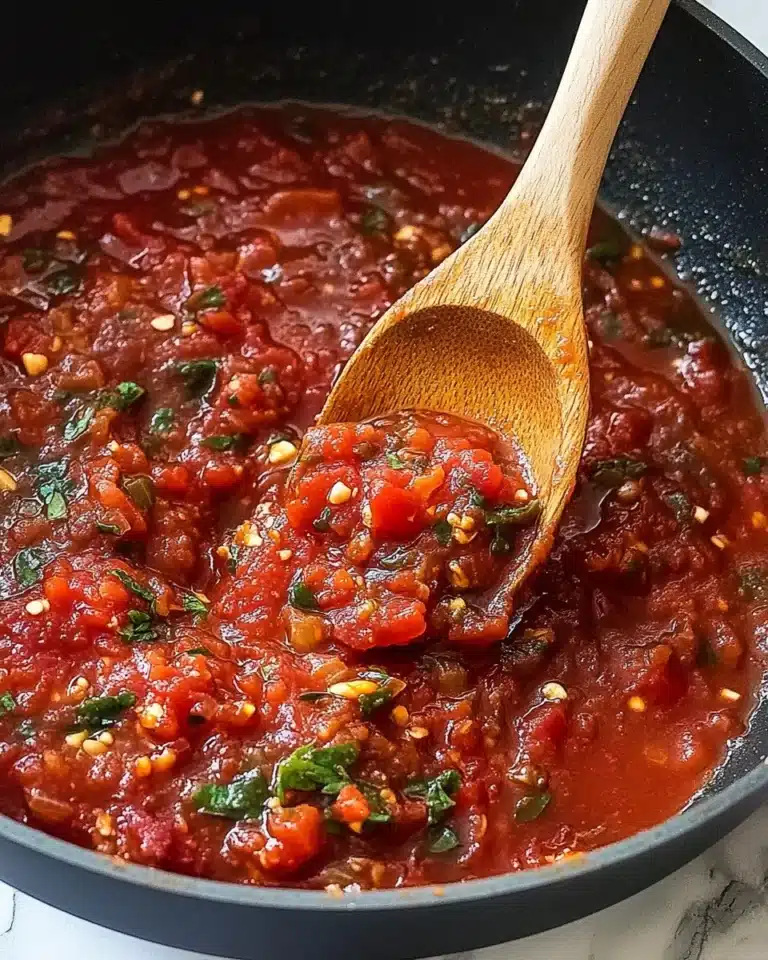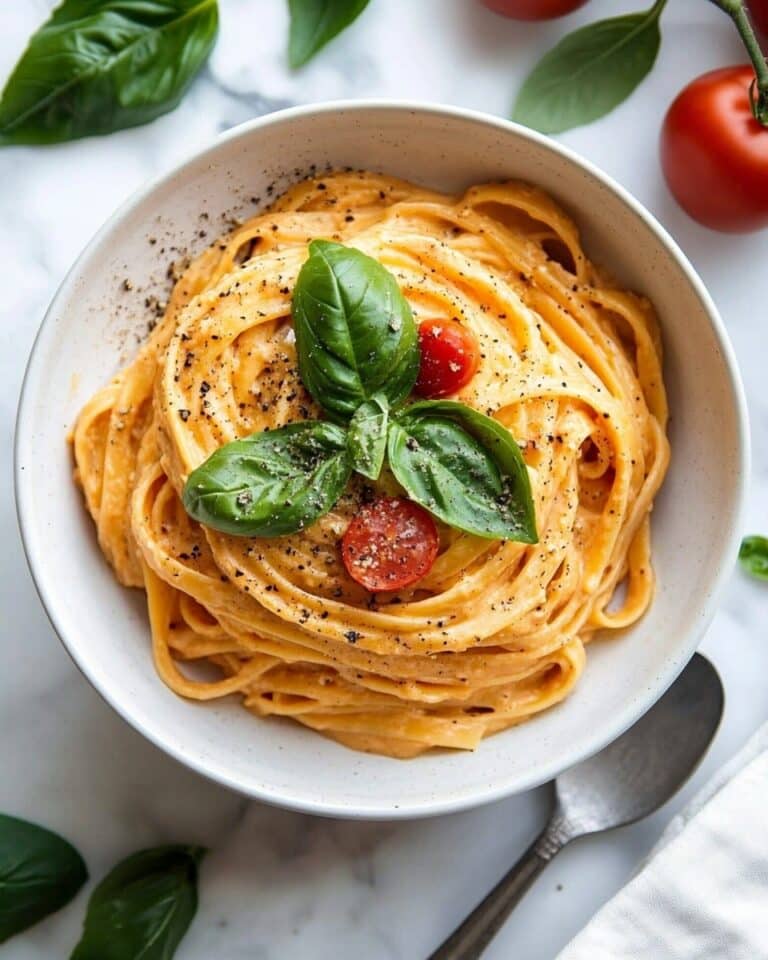If you’re craving something refreshingly sweet and a little chewy, I can’t wait to share this Mango Smoothie with Small Sticky Rice Balls Recipe with you. This dessert-drink combo brings together creamy coconut milk, luscious mango, tender mini sticky rice balls, and those delightful little sago pearls for texture that’ll surprise and delight your palate. It’s such a fan-freaking-tastic treat that my family goes crazy for on warm afternoons. Stick around, and I’ll walk you through every step so that you nail it perfectly at home.
Why You’ll Love This Recipe
- Perfect Texture Combo: The small sticky rice balls and sago add that chewy bite which contrasts beautifully with smooth mango puree and creamy coconut milk.
- Naturally Sweet and Refreshing: Using ripe mango and coconut milk means no extra refined sugar is needed, making it taste fresh and satisfying.
- Easy to Make at Home: Once you know the cooking process for sago and sticky rice balls, it’s surprisingly simple and rewarding to recreate this dessert yourself.
- Great for All Occasions: Serve it chilled for hot days, or enjoy it as a unique dessert after dinner – it’s always a winner!
Ingredients You’ll Need
What makes this Mango Smoothie with Small Sticky Rice Balls Recipe so irresistible? It’s all in those fresh, simple ingredients that complement each other perfectly. I always make sure to pick a ripe mango that’s fragrant and sweet, because that really makes the flavor pop.
- Sago: These tiny pearls add a lovely chewy texture; pick undercooked ones carefully as they’re soft and translucent when done.
- Mango flesh: Fresh is best—look for mangoes that give slightly to touch with a sweet aroma.
- Coconut milk: Opt for full-fat canned coconut milk for richness, but shake it well before using.
- Glutinous rice balls: Also called tang yuan, these small sticky rice balls bring that satisfying chewiness I love and are often store-bought or homemade.
Variations
I love mixing things up with this Mango Smoothie with Small Sticky Rice Balls Recipe, especially when mangoes aren’t quite in season, or when I want to tweak the texture or sweetness to suit different moods and occasions. Feel free to personalize it!
- Tropical Twist: Swap mango with ripe papaya or ripe peaches for a similar sweet and fruity flavor.
- Dairy-Free Alternative: Use almond or oat milk instead of coconut milk if you prefer a lighter taste.
- Extra Sweetness: Add a drizzle of honey or palm sugar syrup if your mango isn’t quite sweet enough.
- Textural Play: Toss in some cooked chia seeds for an additional fun texture that pairs well with sago.
How to Make Mango Smoothie with Small Sticky Rice Balls Recipe
Step 1: Cooking the Sago Pearls to Perfection
Start by boiling a large pot of water—you want quite a bit of water, at least ten times the volume of sago. When it’s rolling, toss in your sago pearls and stir occasionally. This keeps them from sticking together or to the bottom of the pot, which was something I used to struggle with until I got careful about stirring during cooking. Then cover the pot and let it gently simmer for about 20 minutes. You’ll notice tiny white dots forming inside the pearls—that’s your cue to turn off the heat. Let them sit covered for another 20 minutes, which helps the pearls finish cooking and become perfectly translucent. Finally, scoop them out and rinse in a bowl of water to stop cooking and prevent clumping.
Step 2: Boiling the Tang Yuan (Small Sticky Rice Balls)
While the sago is sitting, bring another pot of water to a full boil. Drop in the small sticky rice balls—you’ll want to gently stir to stop them from sticking to one another. As soon as they float to the surface, let them simmer another minute to cook through. Drain and then immediately plunge them into cold water so they don’t stick together. I discovered this trick the hard way when my first batch became one big sticky blob!
Step 3: Preparing the Mango
Grab your mango and give it a good wash. Slice and dice half of the mango into bite-sized pieces—these are what you’ll enjoy chewing on in the finished smoothie. For the other half, mash it with a fork or use a blender to puree if you like a smoother texture. I find blending half the mango with the coconut milk helps create that velvety richness I’m after.
Step 4: Assembling Your Mango Smoothie with Small Sticky Rice Balls Recipe
Now’s the fun part! In your favorite serving bowl, layer in the cooked sago pearls, diced mango, and those chewy little tang yuan balls. Pour over the coconut milk and stir in the mango puree. Give it all a gentle stir so everything comes together in a creamy, fruity, and chewy bite. I love to chill mine in the fridge for an hour or two before serving — it tastes even more refreshing that way, especially on a warm day.
Pro Tips for Making Mango Smoothie with Small Sticky Rice Balls Recipe
- Don’t Overcook Sago: They turn gluey fast, so use timing and water ratio carefully.
- Cold Water Bath For Sticky Balls: Always shock the glutinous rice balls in cold water to stop cooking and keep them chewy, not mushy.
- Ripe Mango Matters: The flavor hinges on mango ripeness—choose fruits with sweet aroma and softness for best taste.
- Chill Before Serving: Letting it rest in the fridge melds flavors and gives you a cool, refreshing dessert.
How to Serve Mango Smoothie with Small Sticky Rice Balls Recipe
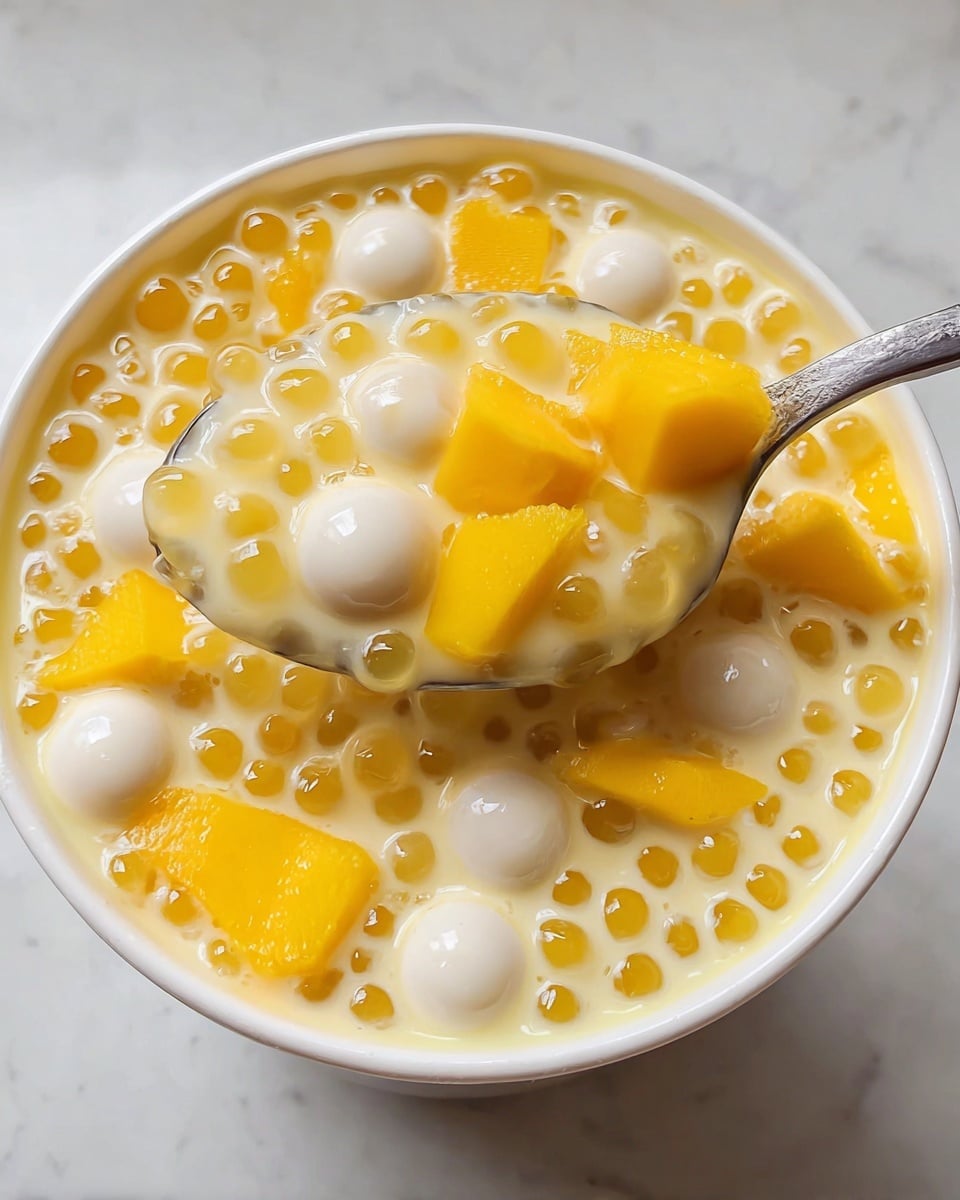
Garnishes
I like to sprinkle a few toasted sesame seeds on top for a subtle nuttiness and a little crunch contrast. Sometimes, a tiny mint leaf goes on top for a fresh aroma that pairs surprisingly well with mango and coconut flavors. You can also drizzle a little extra coconut cream for richness.
Side Dishes
This dessert is satisfying enough on its own, but I’ve found it pairs wonderfully with light snacks like coconut-flavored rice crackers or crispy fried banana fritters if you want something warm alongside. These sides bring out the tropical vibes perfectly.
Creative Ways to Present
For special occasions, I’ve served this Mango Smoothie with Small Sticky Rice Balls Recipe in pretty glasses layered like parfaits – sago pearls at the bottom, then mango cubes, sticky rice balls, and topped with coconut milk puree. It’s visually appealing and adds an element of surprise that guests love.
Make Ahead and Storage
Storing Leftovers
After enjoying a serving or two, I store leftover mango smoothie in an airtight container in the fridge. Because of the coconut milk, it stays good for about 1-2 days. However, the texture of the sticky rice balls can get a little firmer, so I recommend eating it fresh when possible.
Freezing
I don’t usually freeze this recipe, mainly because the ingredients don’t thaw well together — sago and sticky rice balls can become hard and lose their chewy texture. If you want to prepare ingredients ahead, freeze mango puree separately and thaw gently before mixing.
Reheating
If you want to warm leftovers, I suggest gently reheating coconut milk and mango puree separately, then adding fresh cooked sticky rice balls. This way, you avoid texture loss. But honestly, this recipe shines best chilled or at room temperature.
FAQs
-
Can I make the small sticky rice balls from scratch?
Absolutely! If you have glutinous rice flour, you can easily shape small balls at home by mixing with water and boiling until they float. Homemade ones taste super fresh and let you customize the size.
-
What type of mango works best?
Look for ripe, sweet mangoes like Ataulfo or Alphonso if available, but any juicy, fragrant mango will do. Ripe mangoes are softer and naturally sweeter, which really lifts the flavor.
-
How do I know when sago is fully cooked?
Cooked sago pearls become translucent with just a tiny white dot in the center. Letting them sit in hot water after boiling finishes the cooking gently. Avoid overcooking to prevent them from turning mushy.
-
Can I use regular rice balls instead of glutinous ones?
Regular rice balls won’t have the same chewy texture that glutinous rice balls offer. For the best experience, use glutinous rice balls, also known as tang yuan.
Final Thoughts
This Mango Smoothie with Small Sticky Rice Balls Recipe has become one of my all-time favorite treats because it’s simple, refreshing, and feels special every time I serve it. Whether it’s a quick afternoon energy boost or a dessert to impress friends, the mix of textures and tropical flavors hits the perfect note. I can’t wait for you to try it in your kitchen — I promise, once you do, you’ll want to make it again and again!
Print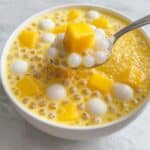
Mango Smoothie with Small Sticky Rice Balls Recipe
- Prep Time: 10 minutes
- Cook Time: 25 minutes
- Total Time: 35 minutes
- Yield: 2 servings
- Category: Dessert
- Method: Boiling
- Cuisine: Thai
- Diet: Vegetarian
Description
This refreshing Mango Smoothie with Small Sticky Rice Balls is a delightful tropical treat combining chewy glutinous rice balls, translucent sago pearls, creamy coconut milk, and fresh mango. Perfectly balanced with textures and flavors, this dessert offers a sweet and satisfying experience that’s ideal for warm days or anytime you want a luscious and exotic snack.
Ingredients
Sago Pearls
- 100 g sago
Mango
- 100 g mango flesh (about 1 mango)
Coconut Milk
- 240 g coconut milk
Glutinous Rice Balls
- 150 g glutinous rice balls (Tang Yuan)
Instructions
- Cook the Sago: Boil a large amount of water, maintaining a water to sago ratio over 10:1. Once boiling, add the sago pearls and stir occasionally to prevent sticking. Cover and simmer gently for 20 minutes. When you notice small white dots in the center of the pearls, turn off the heat. Keep the pot covered and let the sago sit for another 20 minutes. After that, when the sago turns transparent, scoop it out and rinse in a bowl of water to stop the cooking and prevent sticking.
- Boil the Tang Yuan: Bring a separate pot of water to a rolling boil. Add the glutinous rice balls carefully and stir gently with a spatula to avoid clumping. Cook until they float to the surface, then simmer for one more minute to ensure they are cooked through. Remove them from the pot and place in a bowl with water to keep them separate and soft.
- Prepare the Mango: Peel and dice the mango. Use half of the mango to mash by hand or blend with the coconut milk for a smoother puree, if preferred. This produces a rich mango flavor and creamy texture for the smoothie base.
- Assemble: In serving bowls, combine the cooked sago pearls, diced mango pieces, and glutinous rice balls. Pour in the coconut milk along with the mango puree. Stir everything gently to mix the flavors well. For best results, chill the smoothie in the refrigerator for a few hours before serving to enhance the refreshing taste.
Notes
- Use plenty of water when cooking sago to prevent sticking and uneven cooking.
- Stir gently but adequately to keep the glutinous rice balls from clumping together.
- Chilling the assembled dessert enhances its flavors and makes it more refreshing.
- You can adjust the sweetness by adding a bit of sugar or honey into the coconut milk or mango puree if you desire.
- Serve immediately if you prefer a warmer texture, but chilled is recommended for the best experience.
Nutrition
- Serving Size: 1 serving (approx. 250 g)
- Calories: 320 kcal
- Sugar: 18 g
- Sodium: 15 mg
- Fat: 12 g
- Saturated Fat: 10 g
- Unsaturated Fat: 2 g
- Trans Fat: 0 g
- Carbohydrates: 45 g
- Fiber: 2 g
- Protein: 3 g
- Cholesterol: 0 mg

